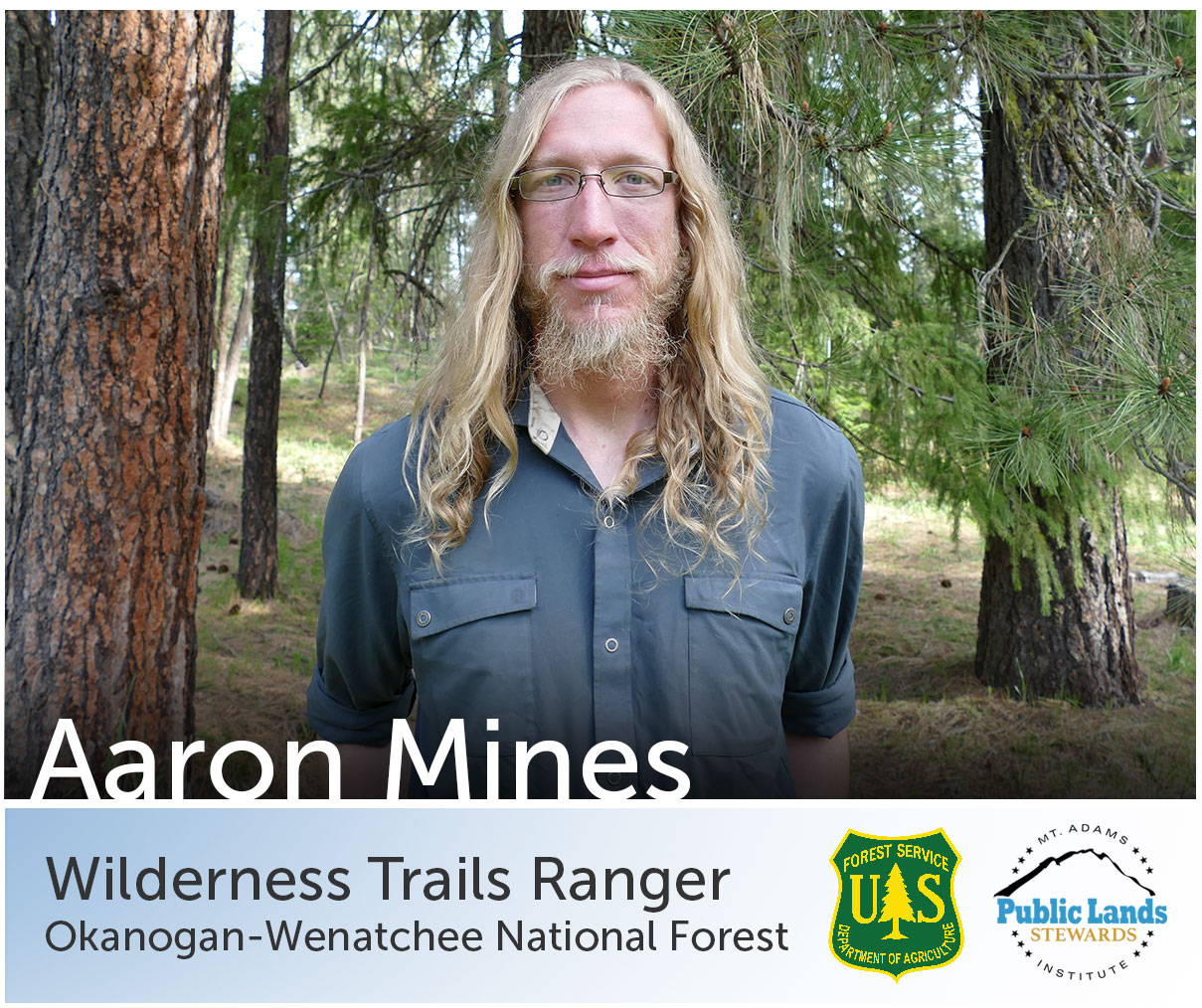
The Lake Chelan area that we have been working on has a large number of trails, from short hour-long trips to destinations that can take 3 days of hard work to get to. A significant amount of our time is spent on one 30-mile stretch of trail and its branching trails.This is the area above Holden Village, around a large alpine lake called Lyman Lake. This area is a popular destination for locals, and being 8 miles away it provides a great location for an overnight adventure or a long day hike from the village. Steep peaks and ridges in all directions surround Lyman Lake, but one large valley provides relatively easy access to the area. Next door are peaks such as Bonanza Peak, the tallest non-volcanic peak in Washington at 9,511 feet, and Glacier Peak, a behemoth of a volcano stretching 10,541 feet above sea level, littered with hot springs and enormous glaciers extending miles in every direction. Lyman Lake, and its smaller brothers the Upper Lyman Lakes, are nestled in a protected basin, have several passes to explore, an active glacier spilling into the highest of these lakes. Abundant wildlife, unforgettable scenery, a touch of history, and vast beaches of glacial silt mark this as one of the most amazing places you could visit in the mountains.
The shore of the lake is primarily a fragile ecosystem, such as this shore here. The area is snow-free for only 3 months out of the year, and the vegetation must find a way to survive this extreme weather. The lake has a huge amount of glacial silt deposits, resulting in a shallow beach about 2 feet deep extending 100 feet into the lake, around the entire perimeter of the lake. At one time, thousands of years ago, a small ridge divided Lyman Lake into 2 smaller lakes. Over time, the glacier and other natural forces eroded this ridge, and the lakes merged into 1 large lake. The remnants of this ridge still exist, directly through the center of the lake. It currently lies only 3-4 feet deep, and is easily navigable by foot. It is quite an experience to walk the 1200 feet from one side of the lake to the other, directly through its center, with the majestic scenery that this basin has to offer. I had the opportunity to walk the lake this summer with fellow AmeriCorps members working with us, during the very short timespan that the lake is warm enough to spend an hour in without getting hypothermia.
The Lyman Lake area is a classic example of a glacier-carved basin supporting multiple small lakes. In contrast to much of the Rocky Mountains, many valleys in the Cascades were carved by glaciers instead of flowing water. The character of the valley is much different, resembling a large “U” shape instead of the valley-carved “V” shape. Here Lyman Lake is clearly visible, as well as the Upper Lyman lakes. At the farthest end of the last lake, the small Lyman Glacier still holds snow year-round. This area was significantly different when hunters and miners made their way here. Climate change in recent years has dramatically reduced the size of this, and all the surrounding, glaciers. When a glacier finally melts out completely, this can have dramatic effects on the landscape, since there is no longer a yearly supply of melt water.
Cloudy Pass hosts a SNOTEL (SNOpack TELemetry) site to monitor snow conditions, and transmit them wirelessly to a receiving facility. This helps scientists and backcountry professionals forecast for avalanche conditions, monitor yearly snowfall averages, and calculate how much water will be available for the coming summer months. Before modern SNOTEL sites, locations such as the one pictured here had merely a tall pole with small signs marking various heights. Forecasters would have to come to the site in person to see how deep the snowpack was. Because this process is significantly more time consuming and less accurate, these sites are nearly all abandoned, being replaced by modern, automated sites. There is a SNOTEL site roughly ¼ mile from where this old post lies.
There are a number of peculiarities in the area, including what we call “The Downside-up Tree”. This ‘tree’ was actually the tip of the next tree over, which had died and broke off some 100’ above the ground. As it fell, it rotated perfectly enough to burrow upside-down completely vertical, just a few feet off of the Pacific Crest Trail. How many through-hikers notice this one?
Wildlife is ever present in the North Cascades. There are hundreds of deer in the area, and they are well used to human presence. They display no fear of us, and may eat your sweaty clothes, as actually happened to one of us AmeriCorps volunteers. They have been raising their fawns around humans recently, because predators will avoid human areas, and this keeps the deer safe. The Fisher is a small animal similar to a marten that lives from the Cascades, up into Canada, and across the continent into New England. They are not too shy, often seen, and their tracks are easily found in the snow. As carnivores, they play an important role in keeping small rodent populations in check. Black bears are also quite common here. In contrast to brown bears, black bears are smaller, less feisty, and want nothing at all to do with humans. They rarely attack people, unless they feel very threatened or they have cubs nearby. Typically, they get scared off before you even know they are there. Much of their diet comes from berries, and there are hundreds of thousands of berry plants in the vicinity. The bear in the photo most likely had a full stomach, as I took that photo during the peak berry season. Even though they are skittish, proper bear precautions must be taken to be safe in bear country.
In recent years there have been a few rare sightings of Gray Wolves in the area. Last year, the AmeriCorps member in my position saw a wolf pair on the high slopes above Lyman Lake. The locals will hear of wolf sightings once, maybe twice a year. Their roaming ground can stretch hundreds of miles, and most sightings come from lucky hunters. This year, I was given quite a special treat, which by sheer luck and coincidence fell on my own birthday. On my first day to the Lyman Lake area, a lone Gray Wolf and I had both come around a sheltered turn of the trail, and simultaneously locked eyes with each other, roughly 25 feet apart. At first movement, he turned and sprinted silently away, not wanting anything to do with me (thus, only a photo of his prints found a few miles away). To be this close to a wolf in the wild, especially in Washington, is a rare thing to happen, and is very unlikely to happen to me again. Wolves were reintroduced to Yellowstone National Park in 1995, and have spread rapidly throughout Wyoming, Montana, and Idaho, but are still not commonly found in Washington. They are an important part of a healthy ecosystem, and with wolves we humans will no longer be the sole predators of deer and other large game. This wolf wasn’t seen again this year, and no other wolves were seen in the area.
This summer has been an adventure, both during my service and with the opportunities available to me during days off. I have been able to not only participate in the recreation available in wilderness areas, but also facilitate its creation and educate for its continued longevity. Wilderness areas have a significant number of hurdles for large projects such as rebuilding burnt trails and failing bridges, most stemming from the difficulty in reaching distant locations and bringing the necessary equipment to these locations. Just as important, though, are the unnoticed small tasks, such as keeping campsites clean and educating visitors with simple questions. I can look back and say with confidence that I not only met my own goals this summer, but am also proud to have been able to help many others do the same through the education and skills that I received and had the opportunity to share as a Public Lands Steward.

